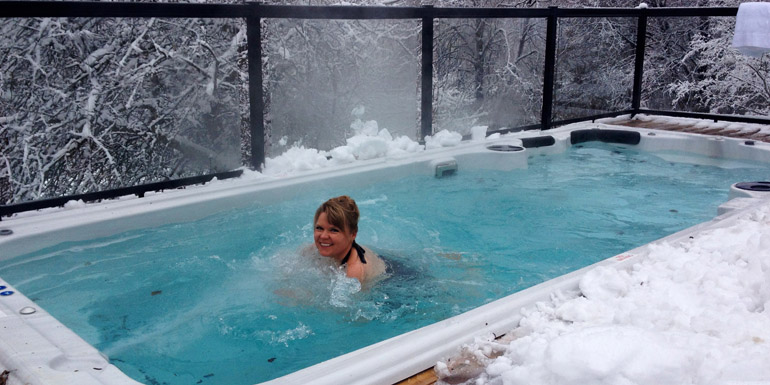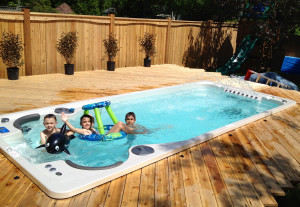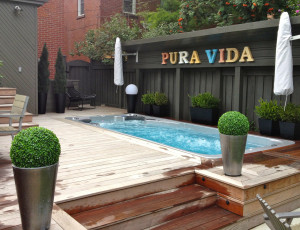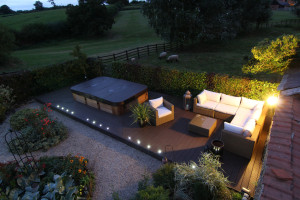Swim spa sales increase as retailers focus on water therapy and fitness
by Sally Bouorm | June 1, 2014 2:28 pm
 [1]
[1]By Jennifer Gannon
For some builders who have traditionally found the installation of swimming pools to be challenging in some backyards—whether due to space or the homeowner’s budget—swim spas have opened the door to just about anyone looking for a large conventional pool. Swim spas, in a sense, are mini-versions of swimming pools, which can be installed just about anywhere, and accommodate swimming in place against a swift current. Where retailers truly benefit is the fact they can also promote the advantage of relaxation—especially after a swim or workout—in one of the jetted hydrotherapy seats these spas also offer.
 [2]
[2]Most swim spas are designed around jet pumps, which create a flat and uplifting current of water that enables continuous swimming up to 13 km/h (8 mph) without turning. The degree of resistance is also variable, which allows the swimmer to set the pace.
The idea of a low-impact exercise routine for improved cardiovascular health is a big selling feature for consumers. Further, swim spas are fun and safe for all ages and abilities; shallow enough for most children and non-swimmers, yet deep enough to satisfy the most serious swimmer, jogger, or water aerobics enthusiast.
Marketing the benefits of aquatic fitness
For customers who are all about aquatic fitness and therapy, some swim spas are designed without side benches, providing swimmers the advantage of maximum arm and legroom—essentially converting the mini-pool into a mini-gym.
In this regard, retailers should stay informed about water aerobics and aquatic training programs as numerous exercises can be performed in a swim spa. In fact, the water’s natural resistance allows people to simultaneously exercise every muscle and joint in the body. Further, the water also serves to cool the body during the routine, which is beneficial during outdoor summer workouts. Many people who like to follow an in-water fitness conditioning program would be interested in these features.
When looking at demographics, in terms of swim spa sales and aquatic fitness, water aerobics is completely inclusive—age and ability are not factors. Therefore, not only is it important to be able to explain this to customers, but also to realize the market potential for these products. For customers who are unsure, it can be easily explained; water allows the body to be buoyant, causing less strain and stress on the joints and muscles.
Besides the cardiovascular and respiratory benefits, aquatic therapy in a swim spa also helps to:
- Increase and maintain muscular flexibility;
- Improve mobility and range of motion;
- Increase muscular strength;
- Improve co-ordination, balance, and posture;
- Burn calories;
- Massage muscles;
- Provide the ability to train during very hot/cold weather;
- Supplement or provide an alternative to regular training;
- Provide a relaxing and pleasurable experience; and
- Offers the body a great alternative to traditional exercise (when the body is supported by water, the exerciser’s heart rate is slightly lower, making aquatic therapy relatively safe for obese individuals, pregnant women, and those suffering from hypertension and heart disease).
A person does not need to know how to swim to take advantage of exercising in a swim spa either. They can wear one of many devices that will enable them to stay afloat with little effort, enabling them to concentrate on their routine. The ideal location to perform water aerobics is in an indoor swimming pool. Alternatively, a heated indoor or outdoor swim spa, where the water temperature is controlled, also works well.
| Treading Water |
|---|
| Water exercise programs have been making a splash and are one of the reasons why swim spas have become popular for many households. Here are some points to share with customers when using their swim spa to perform water aerobics: • Water temperature—warm water relaxes the muscles and eases stiff joints. For an arthritis-oriented program, a water temperature of 28 to 31 C (82 to 88 F) is recommended, with an absolute minimum of 28 C (82 F). • Intensity—exercising in water is so much easier and there may be temptation to overexert. Therefore, to be safe, start off slowly. Tell customers who are new to water aerobics to respect their limitations. • Buddy system—even though the swim spa is typically 4 m (1.2 ft) deep, it is best to have another person present while working out. • Wear supportive clothes that are warm and comfortable. • Wear pool shoes to provide traction while exercising and to protect the soles of the feet from abrasion. • Take a water bottle to the swim spa. Dehydration is a real issue as bathers may not be aware they are perspiring while exercising in the water.For individuals old or young, fit or not so fit, aquatic exercise may help to manage a healthy weight, tone, and maintain bone density. Swim spa users do not need to get their hair wet, or be a swimmer. They are also extremely practical as they function as a personal water gym in the privacy of the customer’s home. |
Sell the convenience aspect
Those who own a swim spa find it easier to follow a fitness routine and, thus, make it part of their daily lives; however, there are several other features that should be discussed with customers to ensure they are purchasing the swim spa best suited to their needs. To do this, make sure customers remain happy with their purchase. It is important to make sure they have researched the product in terms of the swim experience, fun and fitness factors, comfort, design and massage, company/brand reputation, insulation, and ease of maintenance.
The swim experience
When it comes to the swim experience, retailers should discuss the following four elements with their customers to make sure they are choosing the right swim spa. The first is pump design. Will the system provide enough power to achieve the results the user is expecting? Whether the customer is new to exercise, an everyday athlete, or a triathlete, the power of the pumping system, including the size of the plumbing, will help determine the experience.
The swim jet system comes second. It should provide a smooth, turbulence-free swim current. To create this environment, however, the swim jets must have a consistent flow rate capable of producing a flat and powerful current.
The third element is the ability to easily ‘dial in’ (i.e. adjust) the resistance. This is important for two reasons; it allows the swimmer the ability to customize their swim to achieve desired results, and for high-level swimmers, the ability to adjust the current is crucial as it allows for interval training.
The last feature, which some customers may not even consider, is the shell design. Swim spas that have a wide and deep channel, with no protruding steps or seats, provide an unobstructed swim with a consistent, smooth water flow. When demonstrating a swim spa during a ‘wet test,’ for example, show customers how the shell produces little, if any, backsplash. Should backsplash occur, it pushes the swimmer out of the swim lane and disrupts the overall experience. During the demonstration it is also a good idea to explain how the stabilization jets (if equipped) work to push the swimmer to the middle of the swim lane. Finally, if the swim spa also has focus points such as swim lines and lit swim jets to help swimmers identify their position in the swim spa, be sure to highlight these features as well.
Fun and fitness
One of the most overlooked swim spa feature is their ability to provide additional benefits outside of swimming and massage. Today’s customers are looking for an aquatic centre in the backyard that can provide hours of entertainment for the whole family; therefore, it is important to stress these points as well. For example, some swim spas that can provide this type of an experience are fitness related, including rowing machines, tethered swim cords, or in-wall stair climbers. These swim spas can provide the customer with a home gym that is both convenient and effective.
For families looking for more entertainment value in a swim spa, show them models with lit water features that their kids can swim under, or a stereo for more leisurely activities. Some swim spas even have built-in wave pool features, which allow family members to enjoy hours of fun using a tethered boogie board to simulate wave riding in open water.
Comfort, design, and massage
Keep in mind there are many contributing design factors that can make a swim spa more or less comfortable for bathers. For instance, if the swim spa has ergonomically designed seats, let the customer know. This is important because the bather needs to fit comfortably into the seats to get the best possible soaking and massage experience.
 [3]
[3]Let customers climb in and test out the seats. If a seat is not comfortable when it is dry, the odds are it will remain uncomfortable when it is wet. Again, schedule a ‘wet test’ for customers in a fully operational version of the swim spa they are interested in, just like test-driving a car.
Encourage customers to take a closer look at other design features as well, such as multi-level seating, foot-well space, and safety steps. Leave no rock unturned, this way customers can ensure all body types are able to sit in the swim spa, there is plenty of space to accommodate multiple bathers, and ingress and egress is safe and easy.
 [4]
[4]Further, if the swim spa design allows, and depending on the customer’s installation preference, tell them the cost with and/or without the cabinet. Today, an increasing number of swim spas are being installed above-ground as the cabinet finishes the exterior; however, below-grade installations (without the cabinet) remain popular. The latter method allows the consumer to customize the installation, whereby placing the swim spa inground, in a floor, or building a custom-deck surround.
Do not forget to point out some of swim spa’s minor features as well—no matter how miniscule they may seem. For instance, if the swim spa comes with pillows, show how comfortable they are as well as how they can be easily removed and cleaned. If there are cup holders or a place to put an ice bucket, demonstrate these as well as some customers are intrigued by these design features.
 [5]
[5]Despite its name and its intended use, do not disregard the fact one of the most appealing elements of a swim spa is its massage capabilities. When added to the soothing feel of hot water, a swim spa that fails to meet the customer’s massage expectations can truly make or break a sale; therefore, it is critical to highlight these features as much as the fitness aspect.
With respect to massage and relaxation, the swim spa’s jets are vital in providing hydrotherapy. Therefore, explain the different options and benefits regarding varying jet systems. For example, advise customers to look for jets that do not use bearings as a way to avoid problems caused by corrosion. They should also look for a model with optimized hydraulics to ensure an even flow of water is provided to each jet for a smooth, comfortable massage.
| Moderate Growth Projected For Hot Tub Industry |
|---|
 [6] [6]Compiled by Jason Cramp Similar to the swimming pool industry, which was down slightly in 2013, the hot tub market also saw a minor dip in hot tub product last year. Consumers are relaxing in hot tubs Hot tub dollars-and-cents |
Reputation
Today’s customers also do a lot more research on major purchases thanks to the Internet. They will look for swim spa manufacturers with industry longevity and a proven track record in terms of reliability. They will also visit the company’s website and perform a quick search for independent product reviews. Additionally, they will ask friends and/or family members with hot tubs or swim spas about their experience as they are a trustworthy resource.
That said, the manufacturer’s location, along with the retailer/distributor relationship, is also important to the consumer as in their mind it makes getting parts and service easier should challenges occur. Product warranties are significant, too, as consumers will investigate what type of coverage they will get should they purchase a particular product from a specific retailer.
In this regard, they will look for companies that do not charge for service trips when performing a warranty call. And, they will also be weary of the warranty’s small print as many in the industry are pro-rated. Therefore, be sure to offer customers a good warranty, which typically covers the swim spa structure for 10 years, the acrylic surface for five years, and three years on parts and labour.
Some consumers will actually visit a retailer on fact-finding missions to see how they are treated by sales staff as well as to check if the store has an onsite water testing lab and/or an in-house or outsourced service department for ongoing maintenance support. For a swim spa retailer to earn referrals and receive positive comments online it is important for sales staff to take the time to determine what swim spa best suits the customer’s needs rather than push a particular product without asking them any questions. Also, be upfront about the store’s warranty policies and fees (if applicable) on service calls.
Insulation
The swim spa’s insulation factor can also be crucial to a sale in terms of its energy efficiency. This can play an essential role for homeowners looking to enjoy the luxuries of a swim spa, but has concerns about rising electrical prices. Some customers will be looking for environmentally friendly features and some may not, either way it does not hurt to point them out.
Another feature to highlight is low-amperage filtration pumps. In doing this, explain to customers the less time it takes to filter 100 per cent of the swim spa’s water, the more energy-efficient it will be.
Customers may also be intrigued by adjustable venting features; this allows waste heat from the motor to be used to warm-up the water during the winter, or exhausted during the summer.
Finally, do not forget to tell them about the benefits of an insulated swim spa cover with respect to energy efficiency, heat retention, and most importantly, safety.
Ease of maintenance
One of the consumer’s final considerations is ease of service. To help the customer envision where they will install their new swim spa, show them the vital areas where technicians will need access. Otherwise, when it comes to swim spa maintenance, explain the two primary factors they will need to address—filtration and disinfection.
 [7]
[7]When it comes to filtration, dirt can only do two things; it is either light enough to float on the surface or heavy enough to sink. Therefore, when explaining a swim spa’s filtration capabilities, as previously mentioned, tell the customer how long it takes to filter the water. Do not stop there. Give them all the details with respect to the skimmer’s ability to remove surface debris and (if equipped) how the in-floor vacuum removes dirt from the floor.
This leads to the opportune time to explain the difference between suction-side and pressure-side filters. Suction-side filters offer less expensive filtration; however, it only filters 50 per cent of the water. Conversely, pressure-side filters are more expensive, but since 100 per cent of the water passes through the filter, all of the water can be cleaned quicker and more efficiently.
After discussing the filtration method, it is only logical to explain the importance of water disinfection. To keep the swim spa safe and pleasant to use, it is crucial for the customer to understand the importance of regular water maintenance. From in-line chemical feeders and floating dispensers to ozone and saltwater bromine systems, the customer has many options.
Each method has their pros and cons; therefore, retailers need to understand these unique systems and embrace the different technologies. For instance, floating dispensers work well, but the consumer should be made aware they need to remove them every time someone enters the swim spa. Of course, this is not necessary for swim spas equipped with an in-line chemical feeder. Further, ozone systems are designed to reduce the overall chemical requirements; therefore, models that use an injection system are ideal as this technology reduces off-gassing and increases the ozone’s saturation and bacteria killing power. Finally, saltwater bromine systems are effective; however, they require patience and a willingness to learn how the technology works. Once the user understands these systems, they are easy to use and make for a pleasant soaking experience.
The benefits of shopping locally
At times it can be confusing for those shopping for a swim spa; however, by using the focus points discussed in this article, it can make the selection process much easier for customers. Further, having a trustworthy, local retailer on their side to help make their swim spa purchase a reality makes it easy for the consumer to keep in touch with their dealer where they can find help with the operation and maintenance of their new swim spa.
 Jennifer Gannon is a second generation business owner who operates BonaVista LeisureScapes, an outdoor living store in Toronto. She studied English at the University of Western Ontario and has been with BonaVista for more than 15 years before and after a career as an account director at two Canadian advertising agencies. The company is a family-owned and operated business with more than 40 years of experience in custom concrete water projects, backyard spas, and water features. She can be reached via e-mail at jennifer@bonavistapools.com[8]
Jennifer Gannon is a second generation business owner who operates BonaVista LeisureScapes, an outdoor living store in Toronto. She studied English at the University of Western Ontario and has been with BonaVista for more than 15 years before and after a career as an account director at two Canadian advertising agencies. The company is a family-owned and operated business with more than 40 years of experience in custom concrete water projects, backyard spas, and water features. She can be reached via e-mail at jennifer@bonavistapools.com[8]
- [Image]: mailto:jennifer@bonavistapools.com
- [Image]: http://www.poolspas.ca/wp-content/uploads/2015/05/IMG_1680.jpg
- [Image]: http://www.poolspas.ca/wp-content/uploads/2015/05/2X9A0382.jpg
- [Image]: http://www.poolspas.ca/wp-content/uploads/2015/05/DSC_2752.jpg
- [Image]: http://www.poolspas.ca/wp-content/uploads/2015/05/IMG_1998.jpg
- [Image]: http://www.poolspas.ca/wp-content/uploads/2015/05/CoastSpasLS-61.jpg
- [Image]: http://www.poolspas.ca/wp-content/uploads/2015/05/DSC_2738.jpg
- jennifer@bonavistapools.com: mailto:jennifer@bonavistapools.com
Source URL: https://www.poolspamarketing.com/trade/swim-spa-sales-increase-as-retailers-focus-on-water-therapy-and-fitness/